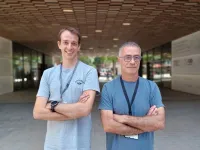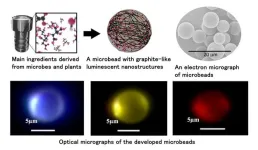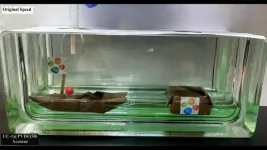(Press-News.org) Researchers have used gene editing to restore hearing in adult mice with a type of inherited hearing loss. They showed that shutting down a damaged copy of a gene called a microRNA (miRNA) enabled the animals to regain hearing. The approach by a research team supported by the National Institutes of Health (NIH), reported in Science Translational Medicine, may eventually lead to potential treatments for inherited hearing loss in people.
Zheng-Yi Chen, DPhil., and his colleagues at Mass Eye and Ear in Boston and other institutions studied a rare form of genetic deafness called autosomal dominant deafness-50 (DFNA50). DFNA50 is caused by mutations in the microRNA-96 (MIR96) gene. MiRNAs are pieces of genetic material that help control gene activity, acting like a master switch. Mutations in miRNAs have been linked to several types of inherited hearing loss. In people with DFNA50, progressive hearing loss develops in the teenage years.
According to Chen, researchers had proved it was possible to use gene therapy (replacing a gene) and gene editing (modifying a gene) to treat genetic deafness in newborn mice, but no one had shown that gene editing was possible in the adult animal inner ear. The human inner ear is fully developed in newborns. In contrast, the newborn mouse inner ear is still developing and changing in structure and function.
“We thought that if we could show we could treat deafness in a fully mature mouse model, we might increase the likelihood it would work in humans,” Chen said.
The scientists focused on a specific mutation in the MIR96 gene. The mutation controls genes important in the development and functioning of hair cells in the ear. Hair cells act as sensors to detect sound and motion and are crucial for hearing.
Chen and his team turned to a CRISPR/Cas9 gene editing approach. Using a type of virus called AAV, or adeno-associated virus, the scientists delivered the gene editing machinery to the inner ear hair cells of mice with the MIR96 mutation and the genetic form of deafness. They tested the treatment on newborn mice before the onset of hearing loss and in adult mice with hearing loss. Treatments at both time points worked, and earlier intervention proved more beneficial.
“Gene editing is useful for this type of genetic deafness because only one gene copy mutation is needed to prevent the entire gene from working properly and causing disease,” Chen explained. “Using gene editing techniques, we prevented the mutation’s effects, essentially eliminating the bad gene copy. The normal gene copy continues to work, and this restores function to the gene.”
Chen said that creating a mouse model that mimicked the genetic mutation and the progressive hearing loss in people with DFNA50 was key.
“We reversed the animals’ hearing loss, and this was sustained for at least nine months,” Chen said. “We think the result should be applicable in people.”
The researchers also showed evidence that the intervention was safe. The delivery virus didn’t integrate into the genome of the cells it infected, which can be concerning for possible side effects.
Chen termed the study a “proof-of-concept” to show this type of gene editing was possible in the adult mouse. To bring this work to the clinic, researchers will need additional preclinical tests in different animal models to make sure the treatment is safe and going to the right cells.
A similar approach can be used for other types of genetic deafness with these kinds of mutations. The scientists developed a method to target more than one MIR96 mutation, making it a promising way to treat multiple forms of hearing loss caused by different mutations in the same gene.
Chen and his collaborators have also reported encouraging results this year from clinical trials looking at a gene therapy approach for another form of deafness, DFNB9.
“There’s been so much progress in understanding and treating genetic hearing loss, and especially the recent success in gene therapy,” said Chen. “Now, we have these results that show new possibilities for genome editing. These advances are bringing in a new era of treatments for people who have genetic deafness.”
Chen and his colleagues were partly funded by the NIH Common Fund’s Somatic Cell Genome Editing (SCGE) program, the National Institute on Deafness and other Communications Disorders, and the National Human Genome Research Institute. NCATS co-leads SCGE along with the National Institute of Neurological Disorders and Stroke.
END
With gene editing, mice with a form of inherited deafness can hear again
Approach restores hearing in adult mice, opening new possibilities to treating genetic conditions in people
2024-07-12
ELSE PRESS RELEASES FROM THIS DATE:
Sant Pau researchers discover a new gene that causes ALS
2024-07-12
Sant Pau researchers discover a new gene that causes ALS
Researchers from the Neuromuscular Diseases Group and the Dementia Neurobiology Group of the Sant Pau Research Institute (IR Sant Pau) and the Memory Unit of the Sant Pau Hospital, led by neurologist Dr. Ricard Rojas-García, have identified a new mutation in the ARPP21 gene that could be the cause of Amyotrophic Lateral Sclerosis (ALS), a devastating neurodegenerative disease.
Specifically, it is a shared mutation (c.1586C>T; p.Pro529Leu) in the ARPP21 gene that ...
Synthetic biology reveals the secrets of life without oxygen
2024-07-12
Long before photosynthesis brought free oxygen into the world, the earth was already populated by numerous organisms. Oxygen was life-threatening for them and therefore they developed completely different metabolic pathways to those we know from plants, animals and humans. Anaerobic bacteria have survived the ages in special, oxygen-free niches, some of them very close to us: as an essential part of the intestinal microbiome, where they are of enormous importance for the well-being of the organism. However, certain anaerobes can ...
UC3M student startup, Solaris Vita, awarded in Europe's largest entrepreneurship competition
2024-07-12
Solaris Vita, a startup created by students at Universidad Carlos III de Madrid (UC3M), has won second place in the "Innovation of the Year" category at Gen-E 2024, the largest European youth entrepreneurship competition, organized by Junior Achievement Europe. This is the first time that a Spanish university team has won this award.
The promoters of Solaris Vita, Miguel Iglesias (Industrial Engineering graduate from UC3M) and Yann Guichard (Economics student at the University), competed ...
How plant cold specialists can adapt to the environment
2024-07-12
Plant cold specialists like the spoonworts have adapted well to the cold climates of the Ice Ages. As cold and warm periods alternated, they developed a number of species that also resulted in a proliferation of the genome. Evolutionary biologists from the universities of Heidelberg, Nottingham, and Prague studied the influence this genome duplication has on the adaptive potential of plants. The results show that polyploids – species with more than two sets of chromosomes – can have an accumulation of structural mutations with signals for a possible local ...
Biomarkers reveal how patients with glaucoma may respond to treatment
2024-07-12
Markers in the blood that predict whether glaucoma patients are at higher risk of continued loss of vision following conventional treatment have been identified by researchers at UCL and Moorfields Eye Hospital.
Over 700,000 people in the UK have glaucoma and it is the leading cause of irreversible blindness worldwide. The condition occurs when the cells in the eye that help you see (called retinal ganglion cells) start to die.
The main risk factors for glaucoma are high eye pressure and older age.
Currently, all licenced treatments are designed to lower pressure in the eye – also known as intraocular pressure. However, some patients ...
Microbeads with adaptable fluorescent colors from visible light to near-infrared
2024-07-12
1. A research team at NIMS has successfully developed an environmentally friendly, microspherical fluorescent material primarily made from citric acid. These microbeads emit various colors of light depending on the illuminating light and the size of the beads, which suggests a wide range of applications. Furthermore, the use of plant-derived materials allows for low-cost and energy-efficient synthesis.
2. Conventional luminescent devices commonly utilized thin films of compound semiconductors containing metals or sintered inorganic materials with rare earth elements. However, in a circular economy, there ...
Neighborhood disadvantage and prostate tumor RNA expression of stress-related genes
2024-07-12
About The Study: In this cross-sectional study, the expression of several stress-related genes in prostate tumors was higher among men residing in disadvantaged neighborhoods. This study is one of the first to suggest associations of neighborhood disadvantage with prostate tumor RNA expression. Additional research is needed in larger studies to replicate findings and further investigate interrelationships of neighborhood factors, tumor biology, and aggressive prostate cancer to inform interventions to reduce disparities.
Corresponding Author: To contact the corresponding author, ...
Screen media use and mental health of children and adolescents
2024-07-12
About The Study: This secondary analysis of a randomized clinical trial found that a short-term reduction in leisure-time screen media use within families positively affected psychological symptoms of children and adolescents, particularly by mitigating internalizing behavioral issues and enhancing prosocial behavior. More research is needed to confirm whether these effects are sustainable in the long term.
Corresponding Author: To contact the corresponding author, Jesper Schmidt-Persson, Ph.D., email jesp@kp.dk.
To ...
Mediterranean diet and cardiometabolic biomarkers in children and adolescents
2024-07-12
About The Study: The findings of this study suggest that Mediterranean diet-based interventions may be useful tools to optimize cardiometabolic health among children and adolescents.
Corresponding Author: To contact the corresponding author, Jose Francisco Lopez-Gil, Ph.D., email josefranciscolopezgil@gmail.com.
To access the embargoed study: Visit our For The Media website at this link https://media.jamanetwork.com/
(doi:10.1001/jamanetworkopen.2024.21976)
Editor’s Note: Please see the article for additional information, including other authors, author contributions ...
A chemical claw machine bends and stretches when exposed to vapors
2024-07-12
Scientists at King Abdullah University of Science and Technology (KAUST) in Saudi Arabia have developed a tiny “claw machine” that is able to pick up and drop a marble-sized ball in response to exposure to chemical vapors.
The findings, published July 12 in the journal Chem, point to a technique that can enable soft actuators—the parts of a machine that make it move—to perform multiple tasks without the need for additional costly materials. While existing soft actuators can be “one-trick ponies” restricted to one type of movement, this novel composite film contorts itself ...
LAST 30 PRESS RELEASES:
Scientists boost cell "powerhouses" to burn more calories
Automatic label checking: The missing step in making reliable medical AI
Low daily alcohol intake linked to 50% heightened mouth cancer risk in India
American Meteorological Society announces Rick Spinrad as 2026 President-Elect
Biomass-based carbon capture spotlighted in newly released global climate webinar recording
Illuminating invisible nano pollutants: advanced bioimaging tracks the full journey of emerging nanoscale contaminants in living systems
How does age affect recovery from spinal cord injury?
Novel AI tool offers prognosis for patients with head and neck cancer
Fathers’ microplastic exposure tied to their children’s metabolic problems
Research validates laboratory model for studying high-grade serous ovarian cancer
SIR 2026 delivers transformative breakthroughs in minimally invasive medicine to improve patient care
Stem Cell Reports most downloaded papers of 2025 highlight the breadth and impact of stem cell research
Oxford-led study estimates NHS spends around 3% of its primary and secondary care budget on the health impacts of heat and cold in England
A researcher’s long quest leads to a smart composite breakthrough
Urban wild bees act as “microbial sensors” of city health.
New study finds where you live affects recovery after a hip fracture
Forecasting the impact of fully automated vehicle adoption on US road traffic injuries
Alcohol-related hospitalizations from 2016 to 2022
Semaglutide and hospitalizations in patients with obesity and established cardiovascular disease
Researchers ‘listen in’ to embryo-mother interactions during implantation using a culture system replicating the womb lining
How changing your diet could help save the world
How to make AI truly scalable and reliable for real-time traffic assignment?
Beyond fragmented markets: A new framework for efficient and stable ride-pooling
Can shape priors make road perception more reliable for autonomous driving?
AI tracks nearly 100 years of aging research, revealing key trends and gaps
Innovative techniques enable Italy’s first imaging of individual trapped atoms
KIER successfully develops Korea-made “calibration thermoelectric module” for measuring thermoelectric device performance
Diversifying US Midwest farming for stability and resilience
Emphasizing immigrants’ deservingness shifts attitudes
Japanese eels, climate change, and river temperature
[Press-News.org] With gene editing, mice with a form of inherited deafness can hear againApproach restores hearing in adult mice, opening new possibilities to treating genetic conditions in people




